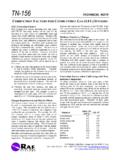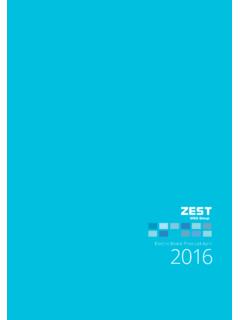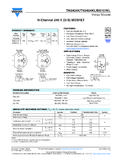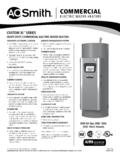Transcription of Should household contacts and other close contacts of a ...
1 Should household contacts and other close contacts of a person with active TB be systematically screened for active TB? Patients: Screening intervention: Comparison: close contacts of active TB cases Symptom screening, chest X-ray screening, or both Passive case-finding Implied purpose: Linked treatment: Reducing TB morbidity, mortality and transmission Treatment of active TB and treatment of TB infection in children aged <5 years Note: See the systematic reviews for full references to cited papers. 1 Fox G et al. Contact investigation for tuberculosis: a systematic review and meta analysis.
2 European Respiratory Journal, 2013, 4:140 156. DOM A IN C R I T E R I A J U D G E M E N T E V I D E N C E C O M M E N T S Burden of illness or problem Is it frequent? Very infrequent Infrequent Moderately frequent frequent Very frequent Across 95 studies in low-income and middle-income countries, the weighted mean prevalence of all types of active TB among household contacts and other close contacts of a person with active TB was (95% confidence interval [CI], ), and the weighted-mean prevalence of microbiologically proven TB was (95% CI, ). In 108 studies in high-income settings, the weighted-average prevalence of all types of active TB among close contacts or household contacts was (95% CI, ).
3 In children aged <5 years in low-income and middle-income countries, the weighted-average prevalence of all types of active TB was 10% (95% CI, ).1 Across 89 studies, the weighted mean number needed to screen (NNS) for all types of active TB in household contacts was 40 (range, 2 568) (Shapiro 2012). The weighted average NNS ranged from 54 in low-incidence settings to 17 in high-incidence settings (Shapiro 2012). Is it severe? Very mild mild moderate severe Very severe* * life threatening or disabling Hosehold contacts and other close contacts of a person with active TB have a high risk of becoming infected.
4 People who have been recently infected with TB have a higher risk of progressing to active disease in the near future compared with people who have distant latent TB infection. household contacts who are aged <5 years, have HIV, or have other diseases that impair their immune system are at a particularly high risk of developing active TB, and are also at high risk for poor disease outcomes. 3a Confidence In accuracy of the diagnostic test What is the confidence in the accuracy of the diagnostic test ? Very low Low Moderate High Sensitivity and specificity (based on van t Hoog et al 2012) Outcome Any cough Cough lasting >2 weeks Any symptom Chest X-ray (any abnormality) Chest X-ray (TB-related abnormality) Effect Quality Effect Quality Effect Quality Effect Quality Effect Quality TP Sensitivity 56% (40 74%) OO Low 35% (24 46%) OOO Very low 77% (68 86%) OOO Very low 98% (95 100%) O Moderate 87% (79 95%) OO Low FP TN Specificity 80% (69 90%) OO Low 95% (93 97%) OO Low 68% (50 85%) OOO Very low 75% (72 79%) O Moderate 89% (87 92%) OO Low FP TP, true positive; FP, false positive.
5 TN, true negative. For further details see the GRADE tables on the accuracy of diagnostic tests. B e n e f i t s a n d h a r m s Overall, are the anticipated desirable effects large? No Yes Modelled yeild of different algorithms based on point estimates from the systematic review of the accuracy of screening tools (van t Hoog et al 2012) and systematic reviews of the accuracy of sputum-smear microscopy2 and the Xpert MTB/RIF test3 Screening Diagnosis Prevalence (500/100 000) Prevalence 1% (1 000/100 000) Prevalence 2% (2 000/100 000) TP FP TN FN TP FP TN FN TP FP TN FN Chest X-ray: any abnormality SSM+CD 344 1890 97610 156 688 1881 97119 312 1377 1862 96138 623 XP 451 245 99255 49 902 244 98756 98 1803 241 97759 197 Chest X-ray.
6 TB abnormalities SSM+CD 305 815 98685 195 611 810 98190 389 1222 802 97198 778 XP 400 105 99395 100 800 105 98895 200 1601 104 97896 399 Cough lasting >2 3 weeks SSM+CD 124 407 99093 376 247 405 98595 753 494 401 97599 1506 XP 162 53 99447 338 324 52 98948 676 647 52 97948 1353 Any symptom SSM+CD 271 2482 97018 229 542 2470 96530 458 1084 2445 95555 916 XP 355 321 99179 145 710 320 98680 290 1420 317 97683 580 1. Cough lasting >2 3 weeks. 2. Chest X-ray SSM + CD 111 179 99321 389 222 178 98822 778 445 177 97823 1555 XP 146 23 99477 354 291 23 98977 709 583 23 97977 1417 1. Any symptom. 2. Chest X-ray SSM + CD 244 1092 98408 256 488 1087 97913 512 976 1076 96924 1024 XP 319 141 99359 181 639 141 98859 361 1278 139 97861 722 TP, true positive; FP, false positive; TN, true negative; FN, false negative; SSM, sputum-smear microscopy; XP, Xpert MTB/RIF test; CD, clinical diagnosis.
7 Overall, are the anticipated undesirable effects small? No Yes Overall, is there certainty of the link between the accuracy of the diagnostic test and the consequences? Very uncertain uncertain Moderately certain Certain Very certain 2 Approaches to improve sputum smear microscopy for tuberculosis diagnosis: expert group meeting report. Geneva, World Health Organization, 2009. 3 Automated real-time nucleic acid amplification technology for rapid and simultaneous detection of tuberculosis and rifampicin resistance: Xpert MTB/RIF system.
8 Policy statement. Geneva, World Health Organization, 2011 (WHO/HTM/ ). Direct assessment of outcomes of screening (Kranzer 2012) For further details see the GRADE tables. C o n f i d e n c e i n b e n e f i t s a n d h a r m s What is the overall confidence in the estimates of effect for benefits and harms? Very low Low Moderate High There is VERY LOW QUALITY evidence that investigating contacts could improve case-detection rates for the population where the investigation is carried out. There is VERY LOW QUALITY evidence that investigating contacts could identify cases earlier than passive case-finding.
9 There is LOW QUALITY evidence that investigating contacts may influence the epidemiology of TB. V a l u e s What is the confidence in the values that patients place on the benefits and harms? Very low Low Moderate High Very high In 24 studies (Mitchell 2012) the weighted average of eligible persons who consented to undergo TB screening during investigation of household contacts was 80%; the range was 39 99%; and the median proportion was 85%. R e s o u r c es Is the cost low relative to the net benefits? No Uncertain Yes No cost effectiveness analysis of contact tracing has been published.
10 Diagnostic category Potential effect Summary of findings Effect No. of studies Quality True positives Benefit on case detection Contact tracing contributed 2 to 19% of all cases 5 cross-sectional studies OOO Very low Benefit on time to diagnosis - 0 studies OOO Very low Benefit on severity at diagnosis Risk of severe x-ray changes at diagnosis RR 1 cross sectional study OOO Very low Benefit on treatment outcome - 0 studies OOO Very Low Benefit on transmission 15% reduction in incidence 22% reduction in prevalence 2 cluster RCTs OO Low False negatives Harm from missed diagnosis - Not reviewed - True negatives Benefit from reassurance - Not reviewed - Harm from














